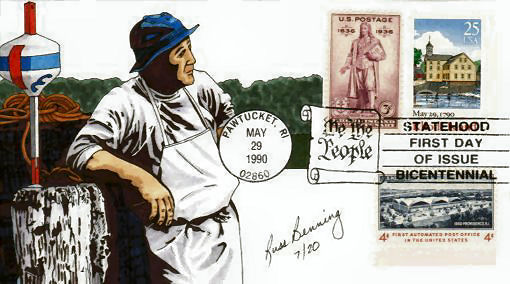![]()
Postal History Introduction
Stampless
Covers
1846
to 1900 Issues
1901-1950
Issues
1951-2003
Issues
Cancels
&
Miscellaneous
Postal
Stationery
Post
Cards
Air
Mail
First
Day &
Event Covers
Parcel Post/Special Delivery
Registered & Official Mail
Commercial & Advertising
Revenue & Postage Due
Wildlife & Game Issues
Complete List of RI Issues
|
Rhode Island First
Day of Issue Covers |
|
|
|
|
Beautiful
Hand Painted Cachet by Russ Benning |
|
|
Facts and History of the Rhode Island Quahog Lobsters, while fished for commercially in Rhode Island are not the shellfish that us Rhodys are noted for. The shellfish that I miss the most since leaving the state is known as a Quahog. The name Quahog comes from the Narragansett Indian word for the hard shall clam, (poquauhock). They are also known locally, depending on their size as "Little Necks, "Cherrystones," "Topnecks," and "Chowder Clams." Quahogs can live as long as 40 years and reach a length of over 4 inches. Their age can be determined by the number of rings on the shell. Keeper's must be at least 1 inch in thickness. When I was growing up in Saunderstown, RI, almost every time we went to the beach we would take along a burlap sack for gathering Quahogs. We would wait for low tide and then wade out to about chest high water. Planting our heels firmly on the bottom we would rotate rapidly back and forth digging into the soft sand on the bottom. The clams could be felt as hard objects beneath our heels. When one was found we would dip down and place it in the sack. Tonguing is the preferred method of most of our local fishermen. The clam tong consists of two long wooden handles, (stales) and two wire mesh baskets with angled teeth for digging into the sand on the business end. Another method in general usage was dredging, however this method severely depleted the existing stocks and today is highly restricted. Rhode Island supplies over a fourth of the country's annual commercial catch and the Quahog is the official state shellfish. Most of the lower bay is open to Quahogging, however most of the upper bay is permanently closed to shell fishing due to pollution. Another Clam found in Rhode Island waters is the soft shell or steamer clam. There is no finer eating than a big kettle of steamers dipped in butter sauce. Steamers are found all along the shoreline in marshy to slightly rocky beach areas and can be located by their distinctive squirt holes. We used a clam rake to gather them when I was younger. My brother says that he now uses a bathroom plunger. The plunger is placed over the squirt hole and used the same way you would unclog your plumbing. The suction created sucks the clam to the surface and also helps to keep the shell from breaking. When I was stationed in southern Maryland, I tried their version of the steamer clam called "Nanos." They are quite similar to their northern cousins, although slightly larger and with a longer neck. My grandmother
made some of the best clam and fish chowders in New England. Here is her recipe for New England Clam Chowder: Hearty New England
Clam Chowder 2 quarts chopped
quahogs (from live clams steamed open) Steam your clams until
they just open, strain and reserve 2 cups of the clam juice. NOTES: 1. Some folks also sprinkle paprika over the surface of the chowder. 2. If you add anything
else such as celery it is quite simply
NOT
a New England chowder. |
|
| SEE ALSO: Rhode Island Superlatives |
![]()
RI Historical Society
The Post Offices
Home Page
RI Tercentenary Issue History
RI Philatelic Society
Recently Added Pages
Philatelic Primer
Rhode Island Around the World
Rhode Island
Town Postmarks
Other Websites of Interest
Return to Ratification
Thumbnails Page 1
